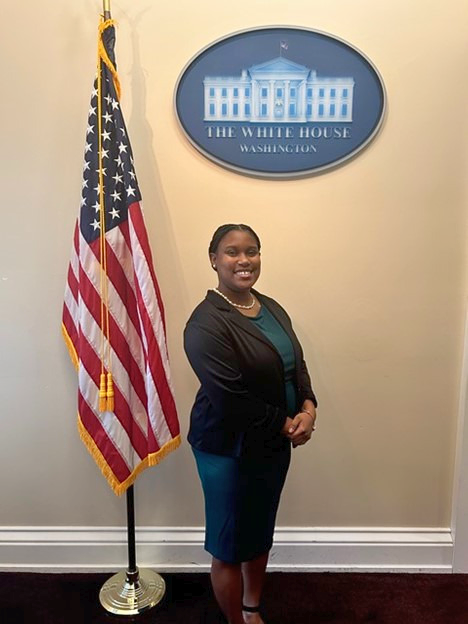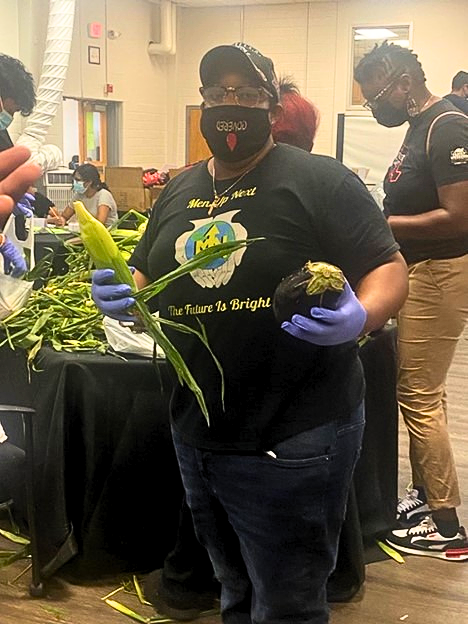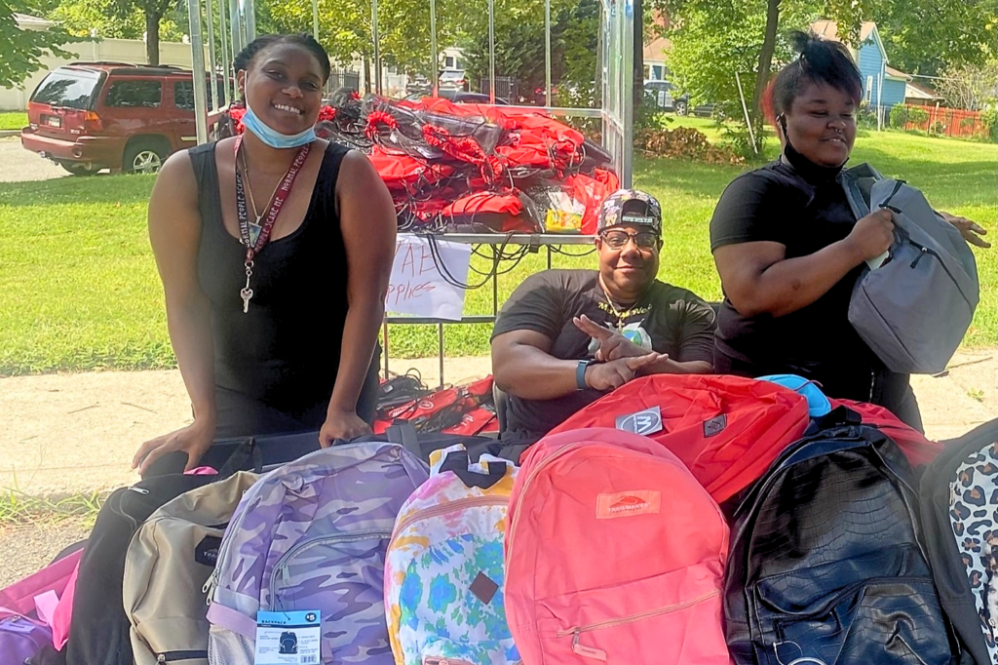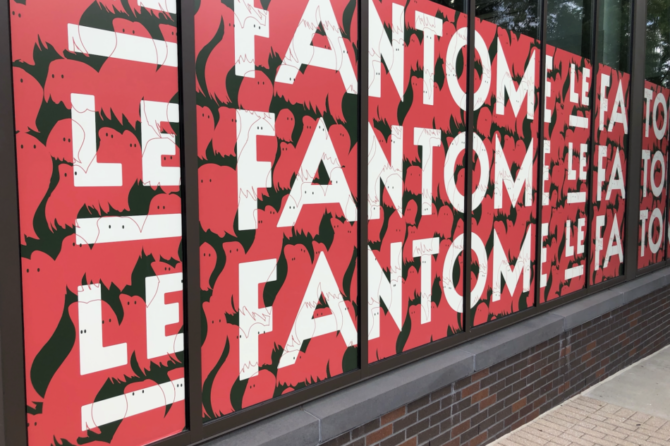MARYLAND MATTERS: Young people are emerging as advocates in the crisis of youth homelessness in Maryland.
In Prince George’s, Baltimore, Frederick and Howard Counties, those efforts are focused at Youth Action Boards, which work to end young peoples’ homelessness.

DaeJanae Day joined youth from across the country to participate in a White House event, “Youth Communities in Action: Building a Better America,” in December. Photo courtesy of DaeJanae Day.
“This gives [us] the opportunity to come to have a seat at the table with stakeholders and providers so they can hear what is really needed in the community,” said DaeJanae Day, 26 co-chair of the Prince George’s County Youth Action Board, her full-time job with the Department of Social Services, who was among four formerly homeless youth interviewed for this story.
Thousands of young people in the state experience homelessness.
“We know that these youth exist. They exist in large numbers, and they are poorly served by the service system, and that’s been true for years,” said Jay Unick, University of Maryland, Baltimore professor of social work and lead investigator for Youth REACH MD, a biennial census, established by state law in 2014.
While a final report is expected soon, Youth REACH program specialist Elizabeth Hoey with the University of Maryland, Baltimore Institute for Innovation and Implementation, said statewide partners have identified 2,789 young people experiencing housing instability.
“The definition we use includes youth who are under the age of 25, not in the physical care or custody of a parent or legal guardian, and lacking a fixed, regular and adequate nighttime residence,” she said.
Unlike the federal Point-in-Time Count which fans out on a single night in late January across the United States to survey the homeless and unsheltered, Youth REACH is conducted over two months in the spring, and coordinates with schools, non-profits, and community groups across Maryland’s 24 counties.
Among other Youth REACH key findings, Hoey said, “Eighty percent of young people identified as a person of color, 28% were LGBTQ-plus, 23% were pregnant or parenting, and 36% [reported] living in two to three places in the past two months.”
Yet, Unick says, youth remain hard to count.
“They don’t see themselves as homeless, when they are couch surfing with an uncle or friend,” he said. “You don’t know how long you can stay there. And, it puts you in a really precarious position very typical for young adults compared to older adults who tend to be either street or shelter-based homeless and consider themselves homeless.”
A grant-funded effort
The Prince George’s County Department of Social Services is working to change that paradigm under a $3.48 million federal Youth Homelessness Demonstration Program grant from the Department of Housing and Urban Development awarded in 2019.
The department worked with over 100 county partners, and a core of youth advisors who had experienced homelessness, to produce the Prince George’s County Coordinated Community Plan. Released in 2020, the plan identified 1,656 homeless youth with as many as 42,000 youth at risk for homelessness.
Its stated goal: “A County where youth homelessness does not exist, and all youth and young adults are heathy, strong, safe, stable, connected and thriving.”
While over the last decade the county has participated in numerous studies, secured housing vouchers, and opened an emergency shelter for youth, Renee Pope, deputy director of Social Services, says the grant funds have allowed them to go further “to engage in a planning process that looked at every level of intervention, both preventive and preemptive,” she said.
Among priority projects Pope lists are a street outreach program, a drop-in center, short and long-term housing initiatives that include youth with physical and mental disabilities, and supportive long-term housing for youth with physical, mental or behavioral challenges.
“That will allow us to stabilize them for a long period of time with some very intensive wraparound support services,” Pope said.
The key to making the plan work is the Youth Action Board, which was the first of its kind established in the state. All 11 members of the panel have lived experience with homelessness.
“The plan is really designed in partnership with them,” Pope said. “Nothing happens in the youth space from concept to design to implementation without them.”
Youth Action Board, decision-makers
As co-chair of the Youth Action Board, DaeJanae Day collaborates with lead staff and stakeholders to set the agenda for the twice-monthly meetings, and helps organize community outreach.
Day has a degree in sociology from the University Maryland Eastern Shore, and is raising a four-year-old daughter. She says it’s her story that motivates her advocacy.
Her life took a downward spiral in high school when her grandmother died, and left her with her mother. She remembers the time as laden with emotional and physical trauma. “I got kicked out of my house twice,” she said, eventually seeking emergency shelter at Promise Place in Prince George’s, while also attending college.
“The only way we can get stuff done is to speak out,” Day said.
Others on Day’s team bring similar backgrounds, and determination.
Shaianne, 21, makes her living at a security company, and says she was a “know-it-all kid,” who kept getting put out of the house. She began house-hopping as a teenager, accruing a fierce sense of independence. “I realized that if I don’t do this, I’m not going to eat. If I don’t do that, I’m not going to sleep,” she said. She ended that cycle at Promise Place, where she eventually learned how to listen and act on the advice. “Now I am in a position, where I can actually give back,” she said. “You might not know what people are going through unless you ask them and take the time to find out.”

Prince George’s County Youth Action Board member Emmanuel Coleman packages food for distribution at the Latin American Youth Center in Riverdale. Photo courtesy of DaeJanae Day.
Emmanuel Coleman, 24, is a party planner at a country club. He began life in foster care and grew up in a series of foster homes until his late teen years, when he was put on the street. Promise Place also helped him get back on his feet. “Since then, I have been talking on panels, and I’ve been eligible to go out in the field, and have my voice heard,” he said.
D.R., 25, tears up as she describes her journey with homelessness, which began around age 5 at a shelter in Virginia, when her maternal grandmother kicked the family out of the house. “I was so young that I didn’t know what was going on,” she said, describing domestic abuse, a stint in public housing, and house-hopping. She attended nine different schools before she eventually dropped out of high school in the 10th grade. Struggling to get her GED, she said, “I’m afraid of failing. Who’s not afraid of that?”
Hearing that, Day interjected, “Our situations don’t define who you are. It just makes you stronger and wiser. We’re a family, and we’re here.”
To further their efforts, D.R wants to host a podcast with a well-known radio host to raise awareness about mental health. Shaianne is spearheading a community field day, and Coleman hopes to host a graduation and prom, for those like him who did not get the chance to walk across the stage.
Also, on the agenda for February is planning for the second GOAT [Greatest of All Times] Mental Health Expo, scheduled for April, while also participating in on-going leadership training workshops.
Promise for homeless youth
Collectively, these four Youth Action Board members and others have worked at food drives, volunteered for Youth REACH (the youth homelessness count) and point-in-time counts, joined national panels, spoken on Capitol Hill and at the White House and have successfully help draft and lobby for state laws. They’ve worked to enact a state college tuition waiver for foster and homeless youth, new laws that allow youth to consent to emergency shelter and services and a bill designed to meet critical mental health and substance abuse needs for youth, which did not pass in the 2022 General Assembly. That measure is under consideration again in 2023 and is included in a bipartisan package of mental health care priorities.
Pope says she’s inspired by the work of the young people and the impact they make. She has learned to trust in their ability to make change in meaningful ways. “They are definitely leaders in their own right, and I’m proud to serve with them,” she said. “I often say, ‘They’re my boss.’”
Day said the Youth Action Board puts youth homelessness in sharper focus within the context of larger systemic problems. “We are cleaning the mess that has been hidden about homelessness, youth homelessness, mental health, food insecurity, housing insecurity and issues with the school system,” she said.
She views their service as an opportunity to raise their voices and to erase the stigma of homelessness.
“We are educated. We are ambitious. We are kindhearted, and we just want to help out,” she said.”
PHoto: Prince George’s County Youth Action Board members (left to right) DaeJanae Day, Emmanuel Coleman and Darlecia D. at the group’s annual back back-to-school book bag drive in August. Photo courtesy of Kelly Gourdin.









